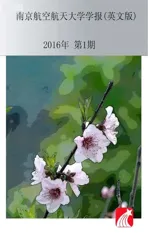Improvement of Mechanical,Dynamic-Mechanical and Thermal Properties for Noil Ramie Fiber Reinforced Polyethylene Composites
2016-05-12ZhangYangXuePingDingYunJiaMingyinShiZhenweiWangHaoInstituteofPlasticMachineryandEngineeringBeijingUniversityofChemicalTechnologyBeijing0009ChinaCentreofExcellenceinEngineeredfiberCompositeUniversityofSouthernQueensland
Zhang Yang,Xue Ping,Ding Yun*,Jia Mingyin,Shi Zhenwei,Wang Hao.Institute of Plastic Machinery and Engineering,Beijing University of Chemical Technology,Beijing 0009,P.R.China; Centre of Excellence in Engineered fiber Composite,University of Southern Queensland,Queensland 4350,Australia
Improvement of Mechanical,Dynamic-Mechanical and Thermal Properties for Noil Ramie Fiber Reinforced Polyethylene Composites
Zhang Yang1,Xue Ping1,Ding Yun1*,Jia Mingyin1,Shi Zhenwei1,Wang Hao2
1.Institute of Plastic Machinery and Engineering,Beijing University of Chemical Technology,
Beijing 100029,P.R.China;
2 Centre of Excellence in Engineered fiber Composite,University of Southern Queensland,Queensland 4350,Australia
Abstract:Noil discarded fibers from fiber production for textile industry have short length and are always considered less valuable.Here,noil ramie fibers/HDPE composite is prepared using twin-screw extruder and the dynamic mechanical and thermal properties are studied.The influence of ramie fiber and maleic anhydride-grafted polyolefin (MA-g-PO) on mechanical,dynamic mechanical and thermal properties is investigated.It is observed that the tensile,flexural and impact properties of the composites treated with MA-g-PO are all improved in comparison to the untreated composites.Dynamic mechanical properties of the composite with MA-g-PO show an increase in the storage modulus with a higher α relaxation peak,together with the micromorphology analysis,indicating an improved interfacial bonding between fiber and matrix by the MA-g-PO addition.Furthermore,the change in TGA thermograms of composite caused by MA-g-PO exhibits that the addition of MA-g-PO is also helpful to increase the thermal stability of noil ramie fiber/HDPE composites.
Key words:noil ramie fiber; high density polyethylene (HDPE) ; mechanical properties; MA-g-PO; natural fiber composites
CLC number: TQ327.9Document code: AArticle ID: 1005-1120(2016)01-0121-08
* Corresponding author,E-mail address: dingyun@ mail.buct.edu.cn.
How to cite this article: Zhang Yang,Xue Ping,Ding Yun,et al.Improvement of mechanical,dynamic-mechanical and thermal properties for noil ramie fiber reinforced polyethylene composites[J].Trans.Nanjing Univ.Aero.Astro.,2016,33(1) :121-128.
http: / /dx.doi.org/10.16356/j.1005-1120.2016.01.121
0 Introduction
Natural fiber reinforced composites attract more and more attention in automobile,building and civil industries,due to their economical costs and environmental benefits[1-4].Natural plant fibers have good physical properties,such as acceptable fiber length,high degree of orientation,and high longitudinal elastic modulus.Compared with glass fibers,natural fiber also has the advantages of lower density,higher specific strength,lower cost and better natural degradability.
In the last few years,many kinds of natural fibers,including flax,jute,hemp,sisal and cotton,have been used to reinforce polymers to improve mechanical properties.Arbelaiz et al.[5]used hemp fiber to reinforce high density polyethylene(HDPE) and found that the mechanical properties of the hemp /HDPE composites could be improved with the increase of hemp fiber.Rahman et al.[6]prepared jute/PP composites by injection molding.The results showed that when the weight content of jute fiber was in the range of 0—25%,the tensile modulus,flexural strength,and impact strength of the composites were improved with the increase of jute fiber.Khondker et al.[7]also explored jute/PP composites prepared by winding and molding method.Mohanty and Nayak[8]prepared sisal/ HDPE composites and explored the dynamic mechanical properties,thermal properties and interfacial adhesion of the composites.Kumar et al.[9]discussed the mechanical performance of coir based mixed composites and demonstratedthat tensile strength increased with increasing the weight percentage of fiber.Paul et al.[10]studied the effect of banana fiber on the mechanical property of polypropylene (PP ).The results showed that the mechanical properties of the composites were increased effectively with the banana fiber adding up to 50%.Kim et al.[11]also investigated the mechanical properties of wood fiber/PP and cotton fiber/PP composites and found that the weight percentage of fibers had an effect on tensile and flexural properties of composites.Although different natural fibers have been used to reinforce polymer,they were mainly scutched fiber which had high content of pectin with low thermal resistance.Noil ramie fibers,as the by-products of ramie fiber used in the textile industry,were highly degummed with better thermal resistance due to their lower pectin content[12-13].
Many works also had investigated the effect of fiber content on mechanical properties of different natural fiber reinforced composite[14-16].But their mechanical performance may be far below their potential values,because the poor interfacial bonding strength between fiber and resin always exists.At the molecular level,natural fiber contains a large number of hydroxyl groups.Hydrogen bond can be formed between the hydroxyl groups,resulting in strong hydrophilic property of natural fiber.On the contrary,polymer matrix such as polyolefins was hydrophobic,which led to poor compatibility between natural fiber and polymer matrix[17].Different kinds of chemical and physical treatments could be used for obtaining better compatibility.Many researches reported that natural fiber surface treated by alkalization,silane coupling,acetylation or maleic anhydridegrafted polyolefin (MA-g-PO),led to the improvement of mechanical properties and thermal stability[18-22].Kabir et al.[23]used alkalization,silane coupling and acetylation treatments to modify the hemp fiber and found that the combination of alkalization and silane coupling was effective in improving the mechanical property of the hemp reinforced polyester composites.Corona or steam explosion was also used in natural fiber treatment to achieve its good compatibility with polypropylene[24-25].Among the studied modifiers,MA-g-PO was proved to be an efficient modifier to improve the interfacial interaction between natural fiber and polymer matrix.Recently,Wang et al.[26]have studied the effect of maleic anhydride-grafted polyethylene (MAPE) on the dynamic behavior of HDPE /hemp short fiber composites.The results showed that the addition of MAPE strengthened the fiber/resin interface and enhanced the dynamic behavior.EI-Sabbagh[27]improved the adhesive force between natural fiber and polypropylene by adding the maleic anhydride grafted polypropylene (MAPP),and the optimum mechanical behaviour was observed after adding 10—13.3 weight percentage of MAPP to the natural fiber reinforced polypropylene composites.
Here we aim to use noil ramie fiber as reinforcement to develop a new kind of green composite.Noil ramie fiber and HDPE were compounded using a twinscrew intermeshing co-rotating extruder followed by injection molding.The effects of interfacial coupling agent on the mechanical,dynamic and thermal properties of noil ramie fiber/HDPE composites were discussed.
1 Experiment
1.1Materials
Virgin HDPE with a melt index of 1.0 g/10 min and density of 0.950 5 g/cm3was obtained from Panjin Chemicals Co.,Ltd.Noil ramie fibers were supplied by Hubei Jiayu Fu Shi Textile Co.,Ltd.Maleic anhydride grafted polyolefin copolymer (MA-g-PO),CMG9801,with a melt flow index of 70 g/10 min and MA content of 1.0 weight percentage,was used to improve the compatibility between HDPE and fibers,purchased from Shanghai Sunny Technology Development Co.,Ltd.In the composites,the fiber content was fixed at 20 weight percentage and the MA-g-PO content varied from 0 to 20 weight percentage.
1.2Noil ramie fiber/HDPE composites preparation
Noil ramie fibers were dried in a vacuum fur-nace at 90℃for 4 h before processing.Noil ramie fibers were compounded with 0.5 weight percentage silane coupling agent,then dry-blended in a high speed mixer at 3 200 r/min for 0.5 h.After that,HDPE,MA-g-PO and the treated fibers were mixed for 30 min in a high speed mixer at 3 200 r/min-1.After compounding,noil ramie fibers/HDPE composite pellets were produced using a 20 mm diameter twin-screw extruder (Kunshan Kesun Rubber&Plastic Machinery Co.,Ltd).The temperature profile along the extruder barrel was 160,165,170,175 and 170℃(from feed zone to die),and the screw rotation speed was 110 r/min.The specimens for tests were molded with an injection-molding machine (PT-130,Zhejiang LiJing Co.,Ltd) from the pellets which were dried at 80℃for at least 24 h before injection.The nozzle temperature was 190 ℃and the injection pressure 70 MPa.
1.3Properties
Universal testing machine (INSTRON 1185,UK) was used for tensile and flexural properties test.Tensile tests were carried out in accordance with ISO 527-1997 with a loading rate of 10 mm / min at room temperature.A three-point loading system was utilized with a crosshead speed of 5 mm /min for flexural tests in accordance with ISO 178-2001.The impact properties were studied using a Ceast 6957 pendulum-type instrumented Resil impact tester (Pianezza,Italy ).The Charpy impact strength was determined for unnotched specimens according to ISO 179-2000 with an impact speed of 2.9 m /s at room temperature.All the results were based on the average value of at least five specimens.
Dynamic mechanical tests were carried out with a DMA 7e spectrometer from PerkinElmer (American) in tensile mode.The value of 0.05% for the strain magnitude was chosen in order to fall into the linear domain of viscoelasticity of the material.The samples were thin rectangular strips with dimensions of about 30 mm×5 mm× 0.5 mm.Measurements were performed in isochronal conditions at 1 Hz with a temperature range from-60 to 100℃at a rate of 3℃/min.
Thermo gravimetric analysis was conducted using Pyris 1,American equipment.Samples were scanned from 50 to 600℃at a heating rate of 10℃/min,in nitrogen atmosphere.The corresponding weight loss was recorded.
1.4Scanning electron microscopy (SEM)
The microstructure of fracture surface of the composites was analyzed using a scanning electron microscope (SEM) (S-4700,Japan Hitachi Inc.),a voltage of 20 kV.The samples were cooled in liquid nitrogen,and then broken.The fracture surface was vacuum-coated with gold for SEM analysis.
2 Results and Discussion
2.1Mechanical properties
The effects of MA-g-PO content on tensile strength and tensile modulus of the composites are shown in Fig.1.It can be seen that the tensile strength of the composite has a great increase of about 13% when the content of MA-g-PO was 5 weight percentage.Tensile strength reaches its maximum at 10 weight percentage MA-g-PO addition and then gradually decreases with further MA-g-PO addition.Elongation at break shows a similar trend and reaches its maximum at 10 weight percentage MA-g-PO addition.The increase of tensile properties was related to the improvement of interfacial property.
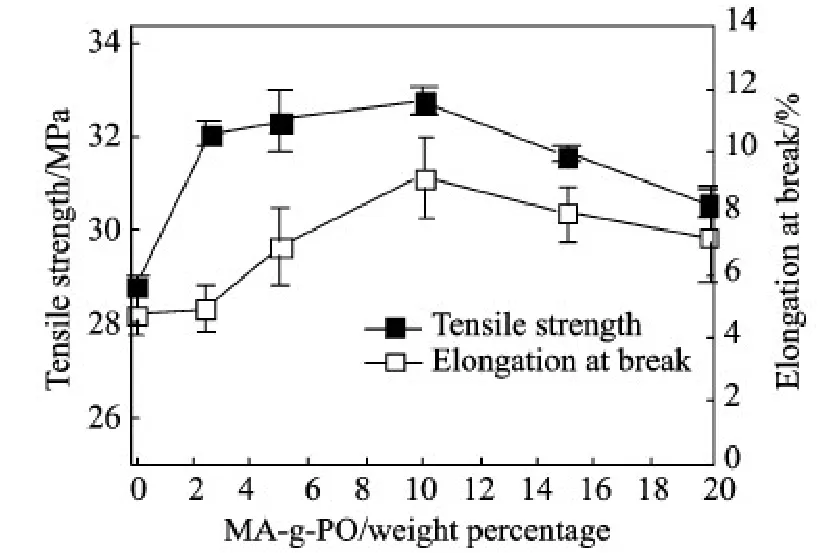
Fig.1 Effects of MA-g-PO content on tensile properties of composites
The effects of MA-g-PO on flexural strength and flexural modulus of the composites are shown in Fig.2.It shows that the effect of MA-g-PO on flexural properties of the composite is similar to that of tensileproperties.The flexural strength and flexural modulus of the noil fiber/PE composites are increased by 15.8% and 33.7%,respectively,with 5 weight percentage addition of MA-g-PO.
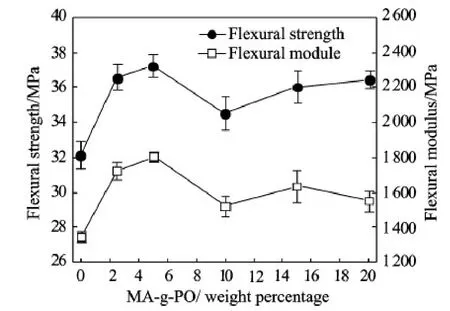
Fig.2 Effects of MA-g-PO content on flexural properties of composites
Fig.3 shows the effects of MA-g-PO on impact strength of the composites.It can be seen from Fig.3 that the impact strength of the composites increases firstly and then decreases with the addition of MA-g-PO.At 10 weight percentage content of MA-g-PO,impact strength of the composite reaches its maximum value of 43 kJ/m2.

Fig.3 Effects of MA-g-PO content on impact property of composites
2.2Micromorphology analysis
The fractured surfaces of noil fiber/HDPE composites with different contents of MA-g-PO are shown in Fig.4.In Fig.4(a),without MA-g-PO,the interface compatibility between noil fiber and HDPE is very poor,corresponding to a large number of fiber pull-outs and big gap between the fiber and polymer matrix.The interface gap can easily cause stress concentration and micro-cracks when force is imposed,thus resulting in poor mechanical properties.Fig.4 (b) shows that the interface compatibility between noil fiber and HDPE is improved with the addition of 5 weight percentage MA-g-PO.This increase in the mechanical strength is primarily attributed to the improved reinforcing effect imparted by MA-g-PO,which allows a uniform stress distribution from continuous polyethylene matrix to the dispersed noil fiber[28].Due to the strong interfacial bonding,the amount of the fibers exposed on the cross section is decreased and the fibers are mainly destroyed by fracture rather than pulling out from the resin matrix.Besides,the imposed radial stress could not easily cause the deformation of the treated fiber,which leads to good interfacial bond force and high mechanical properties.The effect of compatilizer on mechanical properties exhibits marginal improvement when MA-g-PO is in excess of 10%.This is because of the migration of compatilizer around the fibers,as implied from Fig.4(d).The excessive use of compatilizer would cause self-entanglement among the compatilizer rather than the polymer matrix and results in slippage[29].

Fig.4 SEM micrographs of fractured surfaces of composites
It is necessary to research the tensile,flexural strength and modulus of fiber reinforced composites.Based on the above analysis,it can be concluded thatthe optimized and economical amount of MA-g-PO for achieving good mechanical properties and interface compatibility is 5 weight percentage.Therefore,5 weight percentage content of MA-g-PO was added into the composites in the following experiments.
2.3Dynamic mechanical analysis
2.3.1Storage modulus
〗Storage moduli of noil fiber/HDPE composites with and without MA-g-PO treatment,as the function of temperature of virgin HDPE,are shown in Fig.5.It can be seen that there is a notable increase in the modulus when noil fiber is incorporated with HDPE.Storage modulus E' is closely related to the load bearing capacity of the material.This is probably due to the increase of the stiffness of the material and a greater degree of stress transfer at the interface.It can also be seen from Fig.5 that storage modulus of all the samples decreases with the increase of temperature.Virgin HDPE declines more rapidly due to the higher mobility of the molecular chain in HDPE resin in the heated state.The declination of storage modulus of the composite treated with MA-g-PO is less than the untreated composite and virgin HDPE,especially in the temperature range of 0—50℃,where most of the fiber/HDPE composites are used.Thus,it can be concluded that thermal stability of the composite could be further enhanced with the addition of MA-g-PO.
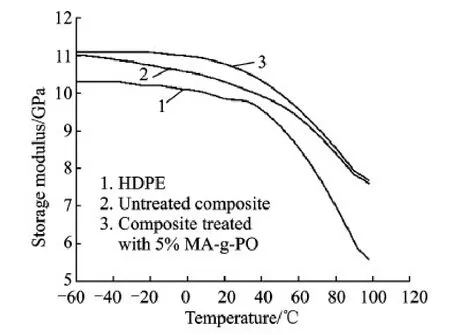
Fig.5 Storage modulus curves for different contents of MA-g-PO
Generally,storage modulus E' is analogous to the flexural modulus E.The E' and E values of virgin HDPE,as well as untreated and treated noil fiber/ HDPE composites at 25℃are listed in Table 1.It can be found that both E' and E are increased in composites.Stiffness of the materials is increased with the addition of noil fibers,and is further increased if the fiber is treated with compatilizer.Nearly 180% increase in flexural modulus and 8% in storage modulus are achieved with the 5 weight percentage addition of MA-g-PO.

Table 1 Flexural and storage modulus of virgin HDPE,untreated and treated composites
2.3.2Loss modulus
Loss modulus E″is closely related to the amount of energy loss.In general,virgin HDPE shows two relaxation peaks at-110℃(γ) and 80℃(α)[30].The α-transition is associated with the relaxation of restricted crystalline phase of matrix and can be attributed to lamellar slip mechanism and molecular chain rotation in crystalline phase.In the present investigation,the α relaxation peaks of virgin HDPE,untreated and treated composites were studied from the loss modulus curves represented in Fig.6.It can be seen from Fig.6 that α relaxation peak of virgin HDPE is detected around 80℃and the relaxation peak exhibits a marginal shift to high temperature regions with the incorporation of noil ramie fibers and MA-g-PO.The maximum temperature of relaxation peak of virgin HDPE,untreated and treated composite and the corresponding loss modulus values are presented in Table 2.The temperature corresponding to the α relaxation peak of virgin HDPE is 84.2℃and the values for untreated and treated noil fiber/HDPE composites are 86.5℃and 89.4℃,respectively.The increase in dissipative temperature is attributed to the presence of noil ramie fibers that reduces the flexibility of the material by introducing constraints on the segmental mobility of polymeric molecules at the relaxation temperatures.
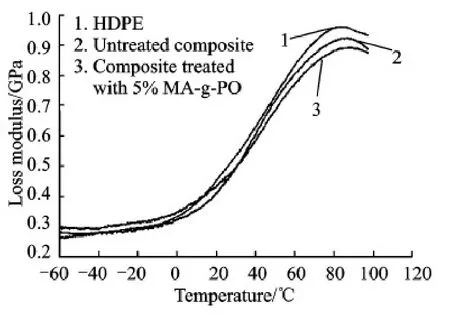
Fig.6 Loss modulus of materials with and without ramie fiber and treatment by MA-g-PO

Table 2 Maximum temperature corresponding to α peak virgin HDPE,untreated and treated composites (20% fiber content)
On the other hand,noil fiber/HDPE composites treated with MA-g-PO have a higher α relaxation temperature than the untreated composites.This can be explained that the molecular motions in the crystalline phase are strongly affected by the addition of treated noil fibers.
2.4Thermogravimetric analysis
Fig.7 shows the thermo gravimetric analysis (TGA) and derivative thermogravimetric analysis (DTG) curves of virgin HDPE and noil fiber/PP composites with and without MA-g-PO.It can be seen that the thermal degradation of all the samples takes place within the temperature range of 50—550℃.Virgin HDPE begins to decompose at 430℃and decomposes completely at 515℃.While the HDPE with the addition of noil fiber begins to decompose at 150℃and a charred residue of carbonaceous products of 3.2% is left at 520℃.The small amount of weight loss in the initial peak probably is attributed to the water absorbed by the hydroxyl of noil fiber cellulose,and the water evaporated very soon.At 400℃,the weight loss of the untreated composite is about 20%.This is probably due to the dehydration from cellulose unit and the thermal cleavage of glycosidic linkage by transglycosylation and scission of C—O and C—C bonds.In the range of 400—520℃,a sharp increase in mass loss can be found for the untreated composites.The treated composites also displays two obvious decomposition processes.The first decomposition occurs in between 320—400℃and the peak value is 389℃as revealed from the DTG (Fig.7 (b) ).It should be noted that the treated composite shows a wider temperature range and higher weight loss than the untreated composite in this range.The second decomposition occurs in between 460—540℃and the main decomposition temperature is around 500℃(Fig.7(b) ).The weight loss at this temperature is about 70% which is primarily attributed to thermal decomposition of the matrix.
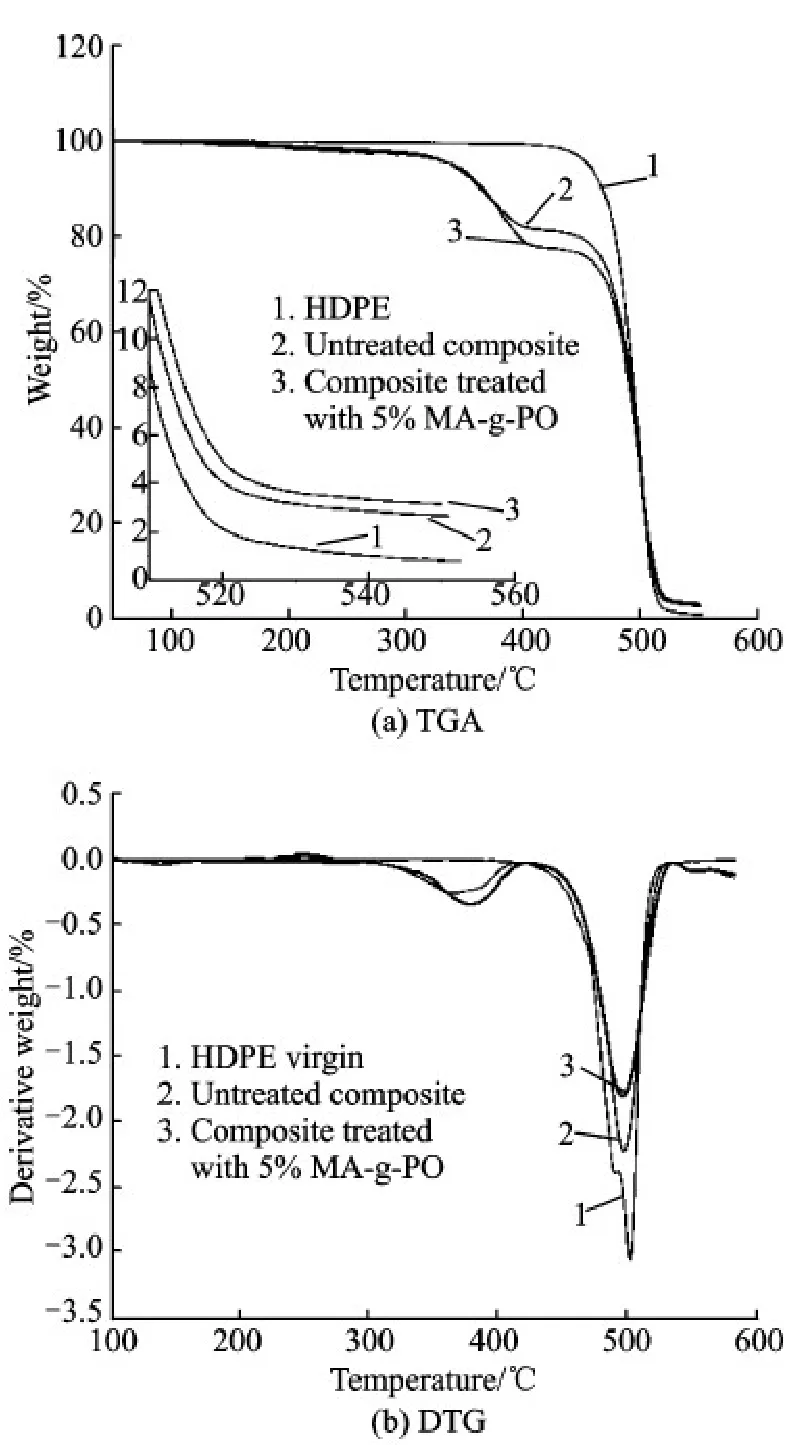
Fig.7 TGA and DTG for virgin HDPE,treated and untreated composites with 20% fiber loading
Table 3 shows the TGA characteristics of pureHDPE,untreated composite and treated composite in the case of 5% mass loss.The results show that 5% mass loss temperatures of the untreated and treated composites are much lower than that of virgin HDPE.In this process,the mass loss of the composites mainly attributes to the dehydration of the cellulose unit and the part decomposition of the C—O and C—C.In addition,it also can be found from Table 3 that the final residual mass ratio of the composites treated with 5 weight percentage MA-g-PO is 3.16%,which is much higher than that of virgin HDPE and the untreated composite,indicating that the addition of noil fiber is helpful to increase the thermal stability of the composite and treated with MA-g-PO can further enhance the thermal stability.
3 Conclusions
Noil ramie fiber/HDPE composites were successfully prepared using twin-screw extruder.With 5 weight percentage content of MA-g-PO,noil fiber/HDPE composite shows an evident increase in tensile strength and flexural strength.Dynamic mechanical analysis indicates that the composites treated with MA-g-PO have enhanced storage modulus and stiffness.The improved composite exhibits a higher α relaxation peak than the untreated composite.TGA and DTG thermograms indicate an increase in the thermal stability of HDPE matrix treated with noil ramie fibers.
Acknowledgements
This work was supported by the National Scientific and Technical Supporting 12th Five-year Plan Project (No.2012BAD23B0203).Thanks Prof.Liu Xiaoming for providing advice and guidance about the results and discussion section of this paper.
References:
[1]FELIX J M,GATENHOLM P.The nature of adhesion in composites of modified cellulose fibers and polypropylene[J].Journal of Applied Polymer Science 1991,42(3) : 609-620.
[2]HAMADA H,IKUTA N,NISHIDA N,et al.Effect of interfacial silane network structure on interfacial strength in glass fiber composites[J].Composites,1994,25 (7) : 512-515.
[3]BELGACEM M N,BATAILLE P,SAPIEHA S.Effect of corona modification on the mechanical properties of polypropylene/cellulose composites[J].Journal of Applied Polymer Science,1994,53(4) : 379-385.
[4]AFAGHI-KHATIB A,MAI Y W.Characterisation of fiber/matrix interfacial degradation under cyclic fatigue loading using dynamic mechanical analysis[J].Composites Part A: Applied Science and Manufacturing,2002,33(11) : 1585-1592.
[5]ARBELAIZ A,FERNANDEZ B,RAMOS J A,et al.Mechanical properties of short fiax fiber bundle/polypropylene composites: Influence of matrix/fiber modification,fiber content,water uptake and recycling[J].Composites Science and Technology,2005,65(10) : 1582-1592.
[6]RAHMAN M R,HUQUE M M,ISLAM M N,et al.Improvement of physic-mechanical properties of jute fiber reinforced polypropylene composites by post-treatment[J].Composites: Part A,2008,39(11) : 1739-1747.
[7]KHONDKER O A,ISHIAKU U S,NAKAI A,et al.Fabrication mechanical properties of unidirectional jute/ PP composites using jute yarns by film stacking method [J].Journal of Polymers and the Environment,2005,13(2) : 115-126.
[8]MOHANTY S,NAYAK S K.Interfacial,dynamic mechanical,and thermal fiber reinforced behavior of MAPE treated sisal fiber reinforced HDPE composites[J].Journal of Applied Polymer Science,2006,102 (4) : 3306-3315.
[9]KUMAR N M,REDDY G V,NAIDU S V,et al.Mechanical properties of coir/glass fiber phenolic resin based composites[J].Journal of Reinforced Plastics and Composites,2009,28(21) : 2605-2613.
[10]PAUL S A,JOSEPH K,MATHEW G,et al.Preparation of polypropylene fiber/banana fiber composites by novel commingling method[J].Polymer Composites,2010,31(5) : 816-824.
[11]KIM S J,MOON J B,KIM G H,et al.Mechanical properties of polypropylene/natural fiber composites: Comparison of wood fiber and cotton fiber[J].Polymer Testing,2008,27(7) : 801-806.
[12]YAN Z L,WANG H,LAU K T,et al.Reinforcement of polypropylene with hemp fibers[J].Composites Part B: Engineering,2013,46: 221-226.
[13]YAN Z L,ZHANG J C,LIN G,et al.Fabricationprocess optimization of hemp fiber-reinforced polypropylene composites[J].Journal of Reinforced Plastics and Composites,2013,32(20) : 1504-1512.
[14]KIM S J,MOON J B,KIM G K,et al.Mechanical properties of polypropylene/natural fiber composites: Comparison of wood fiber and cotton fiber[J].Polymer Testing,2008,27: 801-806.
[15]FENG Y L,HU Y X,ZHAO G Y,et al.Preparation and mechanical properties of high-peformance short ramie fiber-reinforced polypropylene composites[J].Journal of Applied Polymer Science,2011,122:1564-1571.
[16]FARUK O,BLEDZKI A K,FINK H P,et al.Biocomposites reinforced with natural fibers: 2000—2010[J].Progress in Polymer Science,2012,37: 1552-1596.
[17]KALIA S,KAITH B S,KAUR I.Pretreatments of natural fibers and their application as reinforcing material in polymer composites—A review[J].Polymer Engineering and Science,2009,49(7) : 1253-1272.
[18]MOHANTY S,VERMA S K,NAYAK S K.Dynamic mechanical and thermal properties of MAPE treated jute/HDPE composites[J].Composites Science and Technology,2006,66(3/4) : 538-547.
[19]XIE Y J,HILL C A S,XIAO Z F,et al.Silane coupling agents used for natural fiber/polymer composites: A review[J].Composites Part A: Applied Science and Manufacturing,2010,41(7) : 806-819.
[20]SAWPAN M A,PICKERING K L,FERNYHOUGH A.Effect of fiber treatments on interfacial shear strength of hemp fiber reinforced polylactide and unsaturated polyester composites[J].Composites Part A: Applied Science and Manufacturing,2011,42(9) : 1189-1196.
[21]BISWAL M,MOHANTY S,NAYAK S K.Mechanical,thermal and dynamic-mechanical behavior of banana fiber reinforced polypropylene nanocomposites[J].Polymer Composites,2011,32(8) : 1190-1201.
[22]THOMASON J L.Dependence of interfacial strength on the anisotropic fiber properties of jute reinforced composites[J].Polymer Composites,2010,31(9) : 1525-1534.
[23]KABIR M M,WANG H,LAU K T,et al.Mechanical properties of chemically-treated hemp fiber reinforced sandwich composites[J].Composites Part B: Engineering,2012,43(2) : 159-169.
[24]RAGOUBI M,BIENAIMé D,MOLINA S,et al.Impact of corona treated hemp fibers onto mechanical properties of polypropylene composites made thereof[J].Industrial Crop and Products,2010,31(2) : 344-349.
[25]IBRAHIM M M,DUFRESNE A,EL-ZAWAWY W K,et al.Banana fibers and microfibrils as lignocellulosic reinforcements in polymer composites[J].Carbohydrate Polymers,2010,81(4) : 811-819.
[26]WANG K,ADDIEGO F,LAACHACHI A,et al.Dynamic behavior and flame retardancy of HDPE/hemp short fiber composites: Effect of coupling agent and fiber loading[J].Composite Structures,2014,113:74-82.
[27]EI-SABBAGH A.Effect of coupling agent on natural fiber in natural fiber/polypropylene composites on mechanical and thermal behaviour[J].Composites: Part B,2014,57: 126-135.
[28]JOHN M J,ANANDJIWALA R D.Chemical modification of flax reinforced polypropylene composites[J].Composites Part A: Applied Science and Manufacturing,2009,40(4) : 442-448.
[29]RANA A K,MANDAL A,MITRA B C,et al.Short jute fiber-reinforced polypropylene composites: effect of compatibilizer,1998; 69: 329-338.
[30]JOHN B,VARUGHESE K T,OOMMEN Z,et al.Dynamic mechanical behavior of high density polyethylene/ ethylene vinyl acetate copolymer blends: The effects of blend ratio,reactive compatibilization,and dynamic vulcanization[J].Journal of Applied Polymer Science,2003,87(13) : 2083-2099.
Dr.Zhang Yang is currently an lecturer of product design in College of Mechanical and Electrical Engineering at Beijing University of Chemical Technology (BUCT).He received his first degree and Ph.D.degree in BUCT.His research interests are natural fiber reinforced polymer composites and product design.
Dr.Xue Ping is currently a professor and doctoral supervisor at BUCT,as well as the director of Institute of Plastics Machinery and Engineering.His research interests include principle of machining of polymer high-end processing equipment,technology of recycling and high-value utilization of solid wastes,and enhancement mechanism of polymer matrix composites.
Dr.Ding Yun is currently an assistant professor of Polymer Engineering in Institute of Plastics Machinery and Engineering at BUCT.She received her first degree and Ph.D.degree in BUCT.Her research interests lie in natural fiber reinforced polymer composites and high performance functional master batches.
Dr.Jia Mingyin is currently an associate professor of Polymer Engineering in Institute of Plastics Machinery and Engineering at BUCT.He received his first degree and Ph.D.degree at BUCT.His research interests are high performance fiber reinforced polymer composites and polymer processing technology.
Mr.Shi Zhenwei is currently an M.S.candidate of Mechanical Design and Theory in Institute of Plastics Machinery and Engineering at BUCT.He received the B.S.degree at BUCT.His research interests focus on natural fiber reinforced polymer composites.
Dr.Wang Hao is currently a professor at University of Southern Queensland.His research interests include natural fiber reinforced polymer composites and high performance functional master batches.
(Executive Editor: Zhang Tong)
杂志排行
Transactions of Nanjing University of Aeronautics and Astronautics的其它文章
- CFD-Based Load Calculation Method for Monopile Support Configuration of Offshore Wind Turbine
- Critical Stokes Number for Gas-Solid Flow Erosion of Wind Turbine Airfoil
- Numerical Analysis on Motion of Multi-column Tension-Leg-Type Floating Wind Turbine Basement
- Coupled Aerodynamic and Hydrodynamic Analysis of Floating Offshore Wind Turbine Using CFD Method
- Fatigue Assessment Method for Composite Wind Turbine Blade
- Simulation of SLD Impingement on Wind Turbine Blade Airfoil
